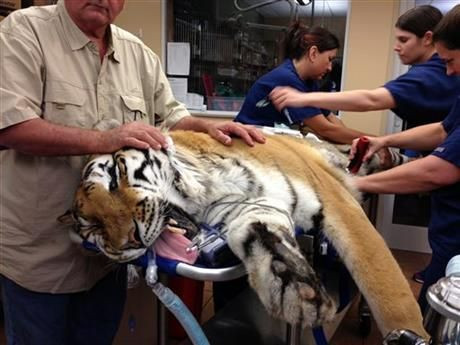Ty, Tiger In Florida, Passes 4-Lb. Hairball Bigger Than A Human Head

Apparently hairballs are a problem for big cats just as much as they are for domesticated ones. Veterinary surgeons in Florida removed a 4-lb. hairball from the stomach of a 400-lb. tiger this Wednesday, according to the Associated Press.
Doctors from the veterinary center in Clearwater located 17-year-old Ty's hindrance using a camera-mounted scope after the animal refused to eat for two weeks. Ty is part of the Wildlife Rescue and Rehabilitation in Seminole, Fla.
Similar to how house cats get hairballs, Ty most likely accumulated a large amount of hair in his stomach and small intestines from his daily hygienic routine. When a cat's fur is ingested, not all of it passes through the digestive system and can get caught in the digestive tract.
The remaining strands of hair form a cluster and are in turn vomited up in an unsavory manner. When Ty was unable to pass his hairball, equal to the size of human head, veterinarians decided that surgery was necessary.
Cats with large hairballs usually experience a loss of appetite, constipation, and diarrhea. Reoccurring hairballs could point to bigger gastrointestinal tract problems such as inflammatory bowel disease and even cancer.
To ensure your 400-lb. tiger (or house cat) doesn't have a problem with hairballs, the American Society for the Prevention of Cruelty to Animals recommends you frequently brush your cat's fur, make sure your pet is getting necessary nutrition from approved cat foods, administer oral or topical hairball medication found at any major pet store, and encourage a new toy if self-grooming becomes excessive.



























